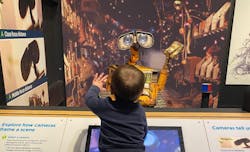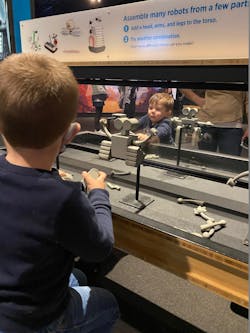Learning from WALL-E
My wife Laura and I recently brought our boys, Jacob and Brandon, to the Museum of Science in Boston. A special Science Behind Pixar exhibit caught our attention, so we bought tickets and took the commuter rail into town. Even though our boys are a bit young for the museum at 4 and 1, they loved it.
The interactive Pixar exhibit was the highlight of the day. The boys got to explore two large rooms and learn about how some of their favorite movies are made, while getting the chance to play. One station that made me think of my job and the market we serve was a robot building setup, where the boys got to assemble different combinations of robots (pictured, with both boys).
Another area that made me think of the machine vision space and the role that cameras play in movies or television involved a replica of the hero robot WALL-E (pictured, with Brandon waving at WALL-E). Specifically, it explains how cameras tell us where to look in a scene, that a close focus distance helps highlight the importance of the plant in the story, while a middle focus distance puts a focus on WALL-E’s reaction. It then explains how a wide field of view establishes a setting and context of a scene, while a narrow field of view shows important characters, objects, and emotions. The exhibit lets guests switch between camera views to get a better idea of how this works. Overall, the special exhibit really gave kids a fun way to learn about science and technology at a young age. We all loved it.
In movies and TV, choosing the right camera to capture these shots is obviously important, just like it is in machine vision and imaging, as a camera’s specs must match the needs of the application. With that in mind, I’d like to once again point your attention toward our annual industrial camera directory, which features products from more than 100 camera manufacturers and distributors. Cameras are identified by manufacturer, product name, sensor type, scan type, resolution, spectrum, interface, and data rate. With the guide, we hope to provide our audience with a useful, convenient method for understanding and comparing the latest cameras on the market.
Looking toward 2021, we are also curious about the types of new or hot-topic-type technologies—including cameras—you may be using, along with how and where. Last year we conducted an audience survey and wrote a subsequent analysis article (bit.ly/VSD-SURV20). We are going to do this again in 2021 and would love to hear from you! Please find a link to the new survey here (bit.ly/VSD-SURV21). We will publish the survey results article in March.
I know 2020 has been a tough year for many, but I do hope that if you are reading this, you enjoy your holiday season and get the chance to spend time with family. That said, I am certainly looking forward to turning a new page in 2021, and I bet many of you are too!

